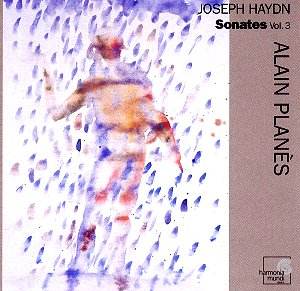There seems no doubt
as to Planès’ devotion to, and
love of, the keyboard sonatas of Haydn.
That is the immediate impression this
disc leaves. Everything is carefully
considered, including the ordering of
these five sonatas, yet there is also
an element of spontaneity there that
makes even a straight-through listen
a joy.
He begins with a sonata
in B minor (No. 47). Planès’
way is bold and direct, his ornaments
clean. He projects the concentrated
argument of the first movement well,
contrasting this with the perky Presto
finale, with its ‘pecking’ repeated-note
theme. His articulation is faultless
throughout.
The opening of the
C minor (No. 33, dating from the same
year as his only quartet in that key,
Op. 17 No. 4) is again, bold, but here
its boldness comes from its bare, sparsely-articulated
delicacy. It is easy to see why some
contemporary critics were against it,
for it demands much of the listener.
The Andante con moto is fully expressive
within its stylistic confines (Planès’
shading of his left hand is most impressive);
the finale this time notable for its
delicacy.
All of which contrasts
magnificently with the next Sonata in
this disc’s running order, No. 50 in
D major. Here the first movement oscillates
between festivity and cheek. Under Planès’
fingers, some passages emerge as reminiscent
of Scarlatti in party-toccata mode.
Planès’ playing is here even
more impressive than Brendel’s (the
latter’s ‘honour’ can sometimes appear
forced on disc). The question of precedents
is again raised in this movement’s slow
movement (‘Largo e sostenuto’) which
is, without doubt, Handelian in breadth,
full of rolled chords and stately dotted
rhythms.
Another D major (No.
61) makes a sterling contrast to No.
50. Beginning with a serious Andante,
it in effect brings the listener down
to earth. The only sonata on this disc
comprising only two movement (its total
duration is under six minutes), it is
pure delight. The only criticism is
that Planès perhaps overplays
the accents in the Presto finale, putting
them on the harsh side.
The recital ends with
the A flat Sonata, Hob.XVI:43 (proportioned
almost identically to No. 47, which
opened the disc, by the way). It is
a marvellous example of understated
genius, revealing its special qualities
slowly. Planès takes risks even
here, just getting away with some staccato
phrase-endings without making them clipped.
The finale is Haydn at his most delicious,
inviting the listener to guess what
he will do next. Indeed, towards the
end of the movement, Haydn seems to
be trying things out, with tempo changes
and registral displacements. The final
chord is a bit of a punch in the stomach,
though!
Recommended without
hesitation. Planès is a Haydn
interpreter to be reckoned with.
Colin Clarke


